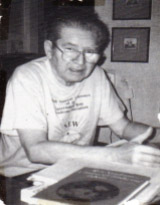Dr Andreas Rett, after whom Rett syndrome is named, was born in Nurnberg, Bavaria, in 1924. By the age of 15, he chose to develop his interest in medicine and, although his plans were interrupted by the Second World War, he did serve as a medic in a German naval hospital during that period.
Immediately following the war, he resumed his medical studies at the University of Innsbruck and gained his doctorate in medicine in 1949. He moved to Vienna the following year where he started medical school. He married fellow physician Jutta in 1952, qualifying as a paediatric specialist in 1955. They had two daughters, Barbara and Andrea.
It quickly became apparent to Dr Rett that there was an urgent need for a handicapped children’s clinic in Vienna and he immediately set about lobbying the local mayor and other politicians to have one established. After many difficulties, including being constantly reminded that he was wasting his time with such children, a 100 bed clinic was opened.
In his early years as a physician, he worked 16 hours a day and cared for every single child with an intellectual disability living in Vienna. At the time, there was no one else who would care for them. He almost lost his practice a couple of times because he refused to stop caring for them. Then came that day in 1960 which would eventually lead to international recognition of the syndrome which was to bear his name. He happened to notice two young girls sitting on their mothers laps in his clinic waiting room, both wringing their hands in the same way. He examined them one after the other, and found they had the same striking developmental histories – early normal development followed by regression, loss of purposeful hand use and compulsive hand movements that were constant. He found 4 other such girls in his practice, made a film of them and took it all over Europe trying to convince people that this must be a syndrome. He also published in obscure German journals which did not reach the attention of a wide scientific community.
At the same time, and unknown to Dr Rett, Dr Bengt Hagberg, from Sweden, had made the same “discovery” in several of his patients. Dr Hagberg discounted Rett’s earlier publications because the Swedish patients did not have elevated blood ammonia as Dr Rett’s patients did (this later turned out to be a mechanical error with the calibrating equipment used by Dr Rett).
The two met at a paediatric meeting in Toronto when Hagberg was at the lecturn talking about his new finding. Rett was in the audience and when he heard Dr Hagberg describe the syndrome, he jumped up from his seat and ran down the aisle to the stage, declaring “Ich Bin Rett “(I am Rett) over and over, delighted and excited to find the connection. He interrupted the meeting, the two men went offstage and discussed the matter. Dr Hagberg returned to the lecturn with the knowledge that the elevated blood ammonia was not correct and they were indeed, talking about the same disorder. In a rare and generous act, Dr Hagberg named the disorder Rett syndrome, changing the title of his ready-to-be published article.
Dr Rett called the Rett girls “his girls”. He longed for the discovery of the cause and worked tirelessly on their behalf. Andreas Rett died on 25 April 1997, two years before the discovery of mutations in the MECP2 gene as the main cause of Rett syndrome. He would have been so elated at this finding.

Acknowledgement
Most of the above information was originally compiled by Kathy Hunter, Founder and President of the former International Rett Syndrome Association and author of ‘The Rett Syndrome Handbook’.
